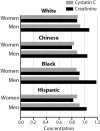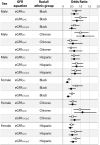Chronic kidney disease prevalence estimates among racial/ethnic groups: the Multi-Ethnic Study of Atherosclerosis
- PMID: 18550650
- PMCID: PMC2518793
- DOI: 10.2215/CJN.04160907
Chronic kidney disease prevalence estimates among racial/ethnic groups: the Multi-Ethnic Study of Atherosclerosis
Abstract
Background and objectives: Muscle mass is not a major determinant of serum cystatin C levels, and its use to estimate GFR may lead to more congruent estimates of chronic kidney disease (CKD) across gender and racial/ethnic groups.
Design, setting, participants, & measurements: The Multi-Ethnic Study of Atherosclerosis is a population-based study of 6814 men and women who are aged 45 to 85 yr and do not have clinical cardiovascular disease. Estimated CKD prevalence, defined as an estimated GFR <60 ml/min per 1.73 m(2) body surface area, was compared using three different GFR prediction equations: The abbreviated Modification of Diet in Renal Disease (MDRD) equation and two equations based on serum cystatin C.
Results: Among women, CKD prevalence estimates across the four racial/ethnic groups using the MDRD- or the cystatin C-based GFR equations, which include gender and race coefficients, varied by approximately two-fold (P < 0.0001) but were more congruent with use of a serum cystatin C-based equation without the use of coefficients (P = 0.3). CKD prevalence estimates did not differ significantly across racial/ethnic groups among men with the MDRD (P = 0.07) or cystatin C formula without coefficients (P = 0.05) but did differ significantly with the cystatin C formula, which incorporates gender and race coefficients (P = 0.006).
Conclusions: CKD prevalence estimates vary across racial/ethnic groups, and the degree of variability depends on the method used to estimate GFR, especially among women. Further research is needed to determine the accuracy and precision of GFR prediction equations in racially diverse populations.
Figures



References
-
- Levey AS, Bosch JP, Lewis JB, Greene T, Rogers N, Roth D: A more accurate method to estimate glomerular filtration rate from serum creatinine: A new prediction equation. Modification of Diet in Renal Disease Study Group. Ann Intern Med 130 :461 –470,1999 - PubMed
-
- Shemesh O, Golbetz H, Kriss JP, Myers BD: Limitations of creatinine as a filtration marker in glomerulopathic patients. Kidney Int 28 :830 –838,1985 - PubMed
-
- Randers E, Erlandsen EJ: Serum cystatin C as an endogenous marker of the renal function: A review. Clin Chem Lab Med 37 :389 –395,1999 - PubMed
-
- Manetti L, Pardini E, Genovesi M, Campomori A, Grasso L, Morselli LL, Lupi I, Pellegrini G, Bartalena L, Bogazzi F, Martino E: Thyroid function differently affects serum cystatin C and creatinine concentrations. J Endocrinol Invest 28 :346 –349,2005 - PubMed
-
- Bokenkamp A, Domanetzki M, Zinck R, Schumann G, Byrd D, Brodehl J: Cystatin C serum concentrations underestimate glomerular filtration rate in renal transplant recipients. Clin Chem 45 :1866 –1868,1999 - PubMed
Publication types
MeSH terms
Substances
Grants and funding
- N01-HC-95162/HC/NHLBI NIH HHS/United States
- N01-HC-95163/HC/NHLBI NIH HHS/United States
- N01-HC-95159/HC/NHLBI NIH HHS/United States
- N01-HC-95165/HC/NHLBI NIH HHS/United States
- N01 HC095159/HL/NHLBI NIH HHS/United States
- R01 DK066488/DK/NIDDK NIH HHS/United States
- N01-HC-95164/HC/NHLBI NIH HHS/United States
- N01-HC-95160/HC/NHLBI NIH HHS/United States
- N01-HC-95161/HC/NHLBI NIH HHS/United States
- N01-HC-95166/HC/NHLBI NIH HHS/United States
- N01 HC095166/HL/NHLBI NIH HHS/United States
- R01 DK066488-01/DK/NIDDK NIH HHS/United States
LinkOut - more resources
Full Text Sources
Medical
Molecular Biology Databases
Miscellaneous

